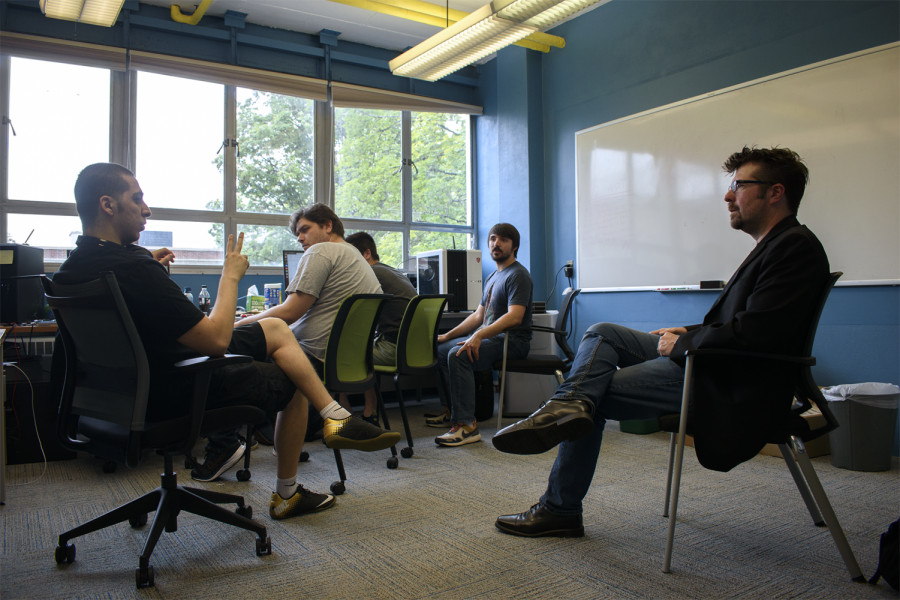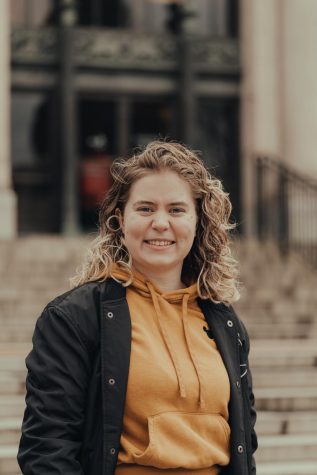OSU professor leads study of gravitational waves
July 4, 2021
Oregon State University physics professor Xavier Siemens will lead and co-direct a $17 million grant that funds the study of gravitational waves to provide insight into how our universe evolves.
The National Science Foundation recently approved the renewal of a grant to fund the United States portion of a large collaboration called NANOgrav, the North American Nanohertz Observatory for Gravitational Waves.
Originally a professor at the University of Wisconsin-Milwaukee, Siemens was first named as the principal investigator for this grant over five years ago. Now that Siemens works at OSU, the grant, which has been recently renewed, will flow through OSU before being sent to other institutions around the country.
“I’m sort of the person responsible for [the grant],” Siemens said. “I’m the person ultimately responsible for the management of these funds and proper execution of the research that we said we would do with those funds.”
The funds of this grant will go to an NSF center that studies gravitational waves through the observation of something called pulsars.
“What we do is we observe these kinds of neutron stars called pulsars [which] emit radio beams from their magnetic poles and they rotate, so they kind of look like lighthouses, and they’re all spread out throughout the galaxy,” Siemens said.
He also described the pulsars and their beams as similar to clocks, which tick on every rotation. So, using radio telescopes, they record the rotation of these beams, and according to Siemens, document when particular pulses from the pulsar arrive. They then use this data to search it for gravitational waves.
“What happens is, if a gravitational wave is passing through the galaxy, it stretches and squeezes the galaxy, and so the times of arrival of those ticks from those clocks changes,” Siemens said.
Essentially, Siemens explained that if a gravitational wave is squeezing the galaxy in one direction then the pulses from affected pulsars will arrive early, whereas if the gravitational wave is stretching the galaxy in the other direction, then pulses will arrive late.
“So depending on the gravitational wave [and] how it’s changing the shape of the galaxy, the time of the arrival of these pulses is changing in a way that we know how to calculate,” Siemens said.
According to Siemens, the specific frequency of the gravitational waves that NANOgrav studies are generally thought to be created by binaries of supermassive black holes.
“So these are two black holes that are billions of solar masses each, and they are orbiting around one another at these time scales, so [it takes a] few years to go around one another,” Siemens said.
These binaries of supermassive black holes are thought to be created when two different galaxies with black holes at their center merge. This merging of galaxies is also believed to be what causes galaxies to evolve.
“When you look at very distant places in the universe, you are seeing the way the universe was a long time ago,” Siemens said. “And when you look at the galaxies that are very distant, they are kind of smaller galaxies than the galaxies that are nearby like the Andromeda or the Milky Way and those galaxies that we have right around us.”
Siemens said these distant galaxies also have fewer stars and tend to be fluffier and less structured than the ones that are closer to us. Thus, the question is how the distant, fluffy galaxies evolve to become like the large and structured galaxies that include the Milky Way and its neighbors.
“The idea is that this happens through an hierarchical set of merges, meaning small galaxies early on merge to form slightly bigger ones and then slightly bigger ones merge again and so on in this hierarchical tree of mergers to arrive at the large, more structured objects [and] galaxies that we see today,” Siemens said.
When these galaxies merge, the black holes meet and start to orbit around each other. They then create the gravitational waves that astrophysicists study and use pulsars to find.
These gravitational waves from these mergers also create something called a “stochastic background,” which is the signal NANOgrav is expecting to detect first, Siemens said. This stochastic background creates something like a hiss or a hum that comes from all of the black holes that are merging in the universe right now.
“What we can do with that signal is solve the inverse problem. Basically, we can say how structure forms in the universe by examining this gravitational wave signal,” Siemens said. “Each signal corresponds to a binary that comes from two galaxies that merge at some point. So we can say things about the way galaxies and therefore kind of structure in the universe evolve.”
The complicated nature of this research means that many different people from different areas are needed for it. While many physicists and astronomers with different backgrounds are involved with this project, Siemens said it also is a collaboration between at least 20 universities in the U.S. as well as people in other countries.
Additionally, there are many graduate students, some of which also attend OSU, who are connected with this project.
Nima Laal, an OSU graduate student in physics, said he is the only person using pulsar timing to lead searches for theories of gravity that are different from Albert Einstein’s theory of relativity.
“In addition to this, I have been heavily involved with the data analysis aspect of pulsar timing with the aim of extracting the signature of gravitational waves from our pulsar timing data over the past two years,” Laal said. “Moreover, I have built and assembled our research group’s computing mini-cluster, which is the best performing in the entire collaboration.”
Laal said his research experience with NANOgrav has given him an aspiration and a goal.
“I believe and know that my work is important, and I am glad to be a part of it,” Laal said.
Another OSU graduate student in physics, Jerry Sun, has been involved with two projects related to NANOgrav. The first relates to the stochastic background of noise that comes from black holes and galactic centers that are orbiting each other.
“What ends up happening is each of these [galactic centers] kicks out a certain sort of wave—if you can imagine a pond full of ripples, a bunch of ripple sources—and the Earth is in the middle of them,” Sun said. “There’s going to be this sort of background humming of all these signals, and that’s one of the searches we do, that I work on personally.”
The second project Sun studies is something called a gravitational wave burst of memory. Sun said they study two objects starting to merge that are kicking out gravitational waves that then merge and stop giving off these waves, because the system is now just one bigger black hole that’s a merged version of the two.
“We call this gravitational wave burst with memory,” Sun said. “The burst part is because as they get closer and closer, they’ll start kicking out waves faster and faster, so we get the little bursts. And then once they merge, because space-time is now permanently changed in the sort of vicinity of that new object, there’s some memory of the event that happened, and we can also pick up that signal.”
As these gravitational waves are studied in more detail, discoveries about them could lead to new and revolutionized information about how our universe works.
“Our work has significant implications for fundamental physics,” Laal said. “Who knows, maybe if we get to know enough about gravitational waves, we can manipulate them in the same way that we manipulate light waves. Manipulation of gravitational waves has the potential to revolutionize everything.”



















































































![Newspaper clipping from February 25, 1970 in the Daily Barometer showing an article written by Bob Allen, past Barometer Editor. This article was written to spotlight both the student body’s lack of participation with student government at the time in conjunction with their class representatives response. [It’s important to note ASOSU was not structured identically to today’s standards, likely having a president on behalf of each class work together as one entity as opposed to one president representing all classes.]](https://dailybaro.orangemedianetwork.com/wp-content/uploads/2025/03/Screenshot-2025-03-12-1.00.42-PM-e1741811160853.png)
























